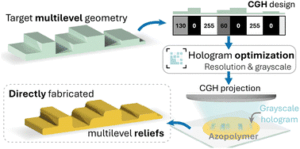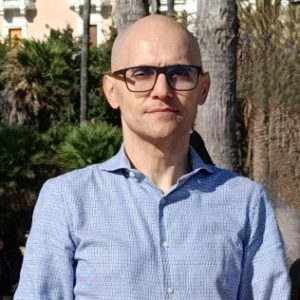
RSC Applied Interfaces publishes interdisciplinary work with an applied focus, which can be read for free here. To celebrate the excellent articles that have been published so far in our journal, we asked some of our authors to discuss their work in more detail.
In this post, we hear from Marcella Salvatore, Francesco Reda, Fabio Borbone and Stefano Luigi Oscurato at University of Naples Federico II, as they discuss their recently published communication article entitled ‘Multilevel azopolymer patterning from digital holographic lithography‘.
Discover the full article here

Multilevel azopolymer patterning from digital holographic lithography
Marcella Salvatore, Francesco Reda, Fabio Borbone and Stefano Luigi Oscurato
RSC Appl. Interfaces, 2025,2, 56-60. DOI: 10.1039/D4LF00358F
From smooth to step-like structures: digital holography enables multilevel azopolymer surfaces
The ability to sculpt surface topography at the micro- and nanoscale has become essential across diverse fields, from biotechnology to optics, from materials science to information security. Structured surfaces are used to control mechanical interactions, modulate light, store data, or encode information. Whether the goal is to guide cells, trap particles, or manipulate light, precisely engineered surface features are often key to functionality. Yet, fabricating such surfaces remains a challenge. While photolithography remains the workhorse of microfabrication, it carries intrinsic limitations. Traditional processes rely on physical masks and multi-step procedures, typically yielding binary geometries and requiring chemical development and etching. These constraints limit design flexibility and pose challenges in terms of sustainability, fabrication speed, and cost, especially when complex or multilevel surface profiles are needed.
In contrast, azopolymer-based photopatterning offers an appealing, all-optical alternative. Unlike traditional photoresists that undergo chemical crosslinking or degradation, azopolymers respond mechanically to light. When irradiated with polarized light, their azobenzene side groups undergo rapid trans–cis isomerization cycles, generating localized stress and driving mass migration within the polymer matrix. This results in macroscopic, stable surface deformations. What sets azopolymers apart is that this response is fully light-driven and reversible. By simply adjusting the illumination pattern, one can write, erase, and rewrite microstructures, enabling the fabrication of reconfigurable functional surfaces. This allows for single-step, direct-write patterning, without the need for etching or development. However, until now, this method has been largely limited to smooth, continuous reliefs, offering limited control over stepwise or grayscale surface geometries.
Breaking through the smoothness barrier
To overcome these limitations, the Holo-Lith group led by Professor Stefano Luigi Oscurato from the University of Naples has advanced a strategy that couples azopolymer-based photopatterning with computer-generated holography. This maskless, all-optical technique exploits the light-responsive behavior of azobenzene-containing polymers and the precision of digital holography. At the heart of this approach is a phase-only spatial light modulator and a Fourier projection system, designed to reconstruct arbitrary-complex and grayscale optical patterns with micrometer-scale resolution. By analyzing the system’s resolution limits and nonlinearities, the group developed an intensity correction procedure based on a Look-Up Table, enabling accurate and linear translation from optical intensity to surface height. This innovation allows for the direct inscription of multilevel, step-like surface reliefs onto azopolymer films.
Writing a 3D QR Code, all with light
To demonstrate the technique, the Holo-Lith group designed a grayscale QR code with controlled variations in pixel intensity. When this holographic light pattern was projected onto the azopolymer film, the surface responded with corresponding multilevel topographies, faithfully encoding the original image as a physical 3D relief. Atomic Force Microscopy measurements confirmed clearly resolved height steps across the pattern, with a linear correlation between input grayscale value and resulting surface height, a critical advance for applications in optical encoding and data storage. This result represents one of the first demonstrations of direct, all-optical fabrication of stepwise, multilevel surface reliefs in azopolymers. The implications span a range of emerging technologies, including hyperspectral data encoding, optical security, tunable diffractive optics, and adaptive surface design. Future directions may involve refining the photomechanical response models and expanding the approach to vectorial light fields, unlocking even more complex surface architectures. In short, this work lays the foundation for a new class of smart, structured surfaces, patterned by light, encoded with light, and reconfigurable through light.
Meet the authors

Marcella Salvatore is an assistant professor at the University of Naples Federico II. She is a materials engineer whose research focuses on azomaterials surface patterning and tuning of the surface functionality. Specifically, she is interested in developing innovative surface designs for applications such as wettability control and optical devices.

Francesco Reda received his PhD in quantum technologies in 2024 from the University of Naples Federico II, with a dissertation on reprogrammable flat optics using maskless photo morphing of azopolymers. Since then, he has been working as a postdoctoral researcher at the same institution, developing holographic techniques for the fabrication of functionalized surfaces.

Fabio Borbone is an associate professor at the University of Naples Federico II. He is a materials chemist whose research interests include the development of advanced materials for photonics, electro-optics, optoelectronics and sensors, with a focus on the design of photoresponsive materials (azomaterials and photopolymers) for photopatterning and surface structuring.

Stefano L. Oscurato is an associate professor at the University of Naples Federico II, where he leads the Holographic Lithography research group. His research focuses on the vectorial light induced structuring of photosensitive materials using computer-generated holograms. He collaborates closely with several world-leading groups in nanophotonics, photosensitive materials, and advanced lithography. In 2024, he was awarded an ERC Starting Grant.
Discover more research published by these authors in our previous blog post and video!

